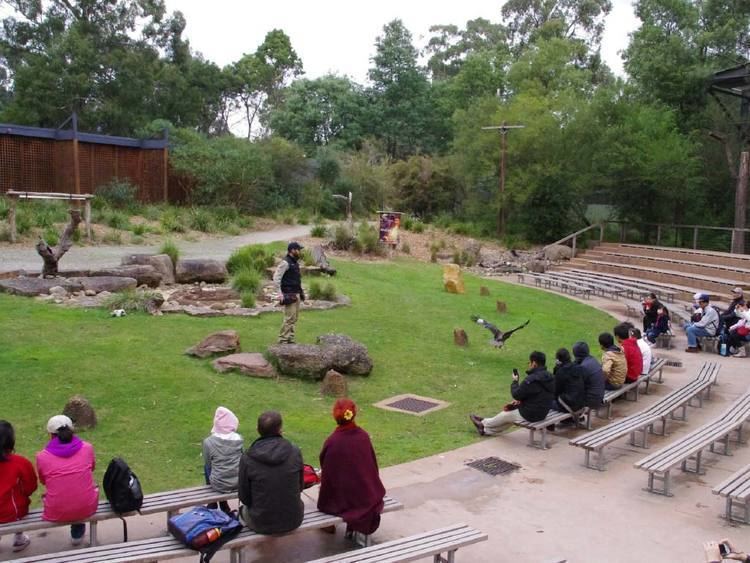Established 1864 Elevation 199 m (653 ft) State electorate(s) Eildon Population 6,567 (2006) | Postcode(s) 3777 LGA(s) Shire of Yarra Ranges Postal code 3777 | |
 | ||
Location 52 km (32 mi) from Melbourne
22 km (14 mi) from Lilydale Weather 17°C, Wind NE at 5 km/h, 67% Humidity Points of interest Healesville Sanctuary, Yarra Valley Railway, Yarra Ranges National, Maroondah Dam, Yarra River | ||
Healesville is a town in Victoria, Australia, 52 km north-east from Melbourne's central business district. Its local government area is the Shire of Yarra Ranges. At the 2011 Census, Healesville had a population of 6,839.
Contents
- Map of Healesville VIC 3777 Australia
- History
- Present
- Sport
- Notable people
- Tourism
- Film and television
- References
Map of Healesville VIC 3777, Australia
Healesville is situated on the Watts River, a tributary of the Yarra River.
History
The creation of a railway to the more distant Gippsland and Yarra Valley goldfields in the 1860s resulted in a settlement forming on the Watts River and its survey as a town in 1864. It was named after Richard Heales, the Premier of Victoria from 1860–1861. The post office opened on 1 May 1865. The town became a setting off point for the Woods Point Goldfield with the construction of the Yarra Track in the 1870s.
Present
Healesville is well known for the Healesville Sanctuary, a nature park with hundreds of native Australian animals displayed in a semi-open natural setting and an active platypus breeding program.
The Yarra Valley Railway operates from Healesville Station on every Sunday, most public holidays and Wednesday to Sunday during school holidays.
Schools in Healesville include the Healesville Primary School, St Brigid's Catholic primary school, the rural Chum Creek Primary School, Badger Creek Primary School, Healesville High School and Worawa Aboriginal College, an Aboriginal school whose former students include noted Australian Rules Footballer David Wirrpanda. Much of what is now Healesville lies on the ancestral land of the Wurundjeri people. The Coranderrk mission station, set up in 1863, is located just south of the main township.
Industries in and around Healesville include sawmilling, horticulture, tourism and, more recently, viticulture.
The Salvation Army has been part of the community since the late 19th century, with a continued and renewed presence in town.
Healesville has an active CFA (Country Fire Authority) volunteer fire brigade established in 1894 which has been active in the community and still is to this day. The Healesville Rural Fire Brigade was formed in 1941 and disbanded and membership amalgamated with the Healesville Urban Fire Brigade in 1985. The amalgamation of the Chum Creek Rural Fire Brigade with the Healesville brigade occurred in 1996. The Healesville Fire Brigade now operates a main and a satellite station with members from both the Healesville and Chum Creek areas.
Sport
The town has an Australian Rules football team, The Bloods, competing in the Yarra Valley Mountain District Football League.
Healesville also has a tennis club, the Healesville Tennis Club, which competes in the Eastern Region Tennis junior and senior competitions.
Healesville has a picnic horse racing club, Healesville Amateur Racing, which holds around seven race meetings a year with the Healesville Cup meeting in January.
The Healesville Greyhound Racing Club also holds regular meetings.
Golfers play at the course of the RACV Country Club on Yarra Glen Road.
Healesville also has an association football team known as Healesville Soccer Club that plays in the Football Federation Victoria league.
Notable people
Tourism
From the late 1890s elaborate country retreat residences were built alongside hotels and guest houses.
A Tourist and Progress Association was created before 1914.
In the 1920s the association published "Healesville, The World-famed Tourist Resort", listing over 40 beauty spots and 20 hotels and guest houses. The construction of the Maroondah Dam in 1927, replacing the weir, brought several hundred workmen to Healesville. Their departure and the onset of the 1930s depression exposed Healesville's restricted range of industries. Timber and tourism were not stable enough for sustained growth. Notwithstanding the depression, the 1930s saw increased motor tourism (partly bypassing Healesville) and decreased railway patronage. Only 10% came by rail at Easter 1934. Tourism was still active but a local newspaper commented that Healesville would be "heaps better off calling itself the good-time town instead of the world-famed-tourist-resort—that's got whiskers on it".
After being Melbourne's playground at the turn of the 20th century, with a plethora of B&Bs available, Healesville has become a tourist destination again. It is home to Healesville Sanctuary, Badger Weir Picnic Area, Yarra Valley Railway, Healesville Organic Market, and volunteer-run events such as the Healesville Music Festival, Open Studios, and the Yarra Valley Rodeo.
It has now become a social hub of the Yarra Valley and the greater district of Melbourne with a range of cafes and restaurant usually seen in inner city suburbs. The Healesville Hotel has been standing since 1910. The pub was revamped in the late 1990s. The Grand Hotel was built in 1880 and is another Yarra Valley icon. Known as "The Grand Old Lady", the hotel offers a seasonal menu, accommodation and entertainment.
Film and television
The Internet Movie Database has Healesville and its environs as the filming locations for a number of films and TV programs: the Australian TV series Young Ramsay (1977), Felicity (1979), the natural history TV series Life on Earth (1979), Frog Dreaming (1986), the Australian TV short film Harry's War (1999) and Killer Elite (2011).
